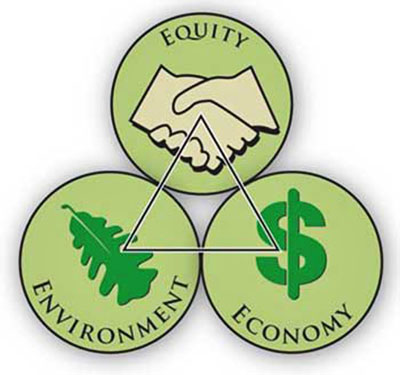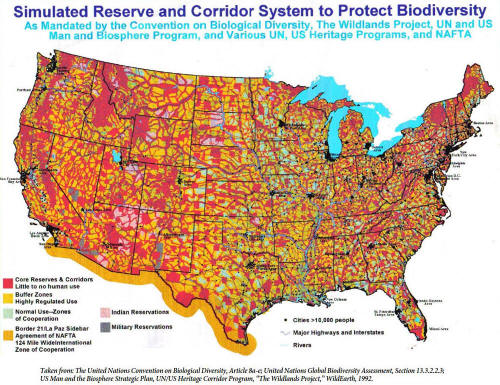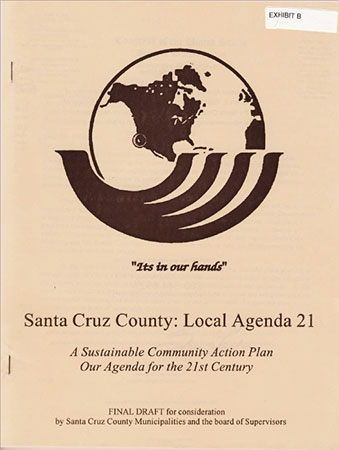|
from BeRealTruth Website
Quoting from the UN website:
Many have said that Agenda 21 is now outdated policy that's fallen into neglect. This is far from true.
For example, among many other things, the slow-motion train wreck of our ongoing world economic collapse supports UN Agenda 21, and the UN conference on "Post-2015 Sustainability Agenda" coming this September is a clear reiteration.
Apologists say that Agenda 21 is only "Soft Law," a policy that has no teeth. But they're lying. In 20 years, through stealth implementation, this plan has become embedded in local policies all over the United States.
It's called Sustainable Development.
Wherever you see it you'll find "The 3 E's:"
In the upcoming UN conference, where the
Jesuit Pope
Francis will be appearing to
promote his recent encyclical, they're being called "People, Planet
and Prosperity."
16 to 17 thousand "delegates," who were somehow given official status as officers of the UN, travelled from all over the world to take part in an 11 day party in Rio De Janeiro, where they were presented with Agenda 21, The United Nations Program of Action from Rio, a more than 300 page document that they were asked to approve, though it seems unlikely that many of them could have had time to even read it.
Unsurprisingly, they voted to accept it,
and it was suddenly official United Nations policy for the world.
This is the genius behind the ways this
program of worldwide social engineering has been rolled out, as
well-meaning people are enrolled as supporters through
poetic-sounding but fuzzy phrases, pledges of concern for the masses
of humanity, and clever misdirection.
Strong first took the world stage
prominently as "Secretary General," a title the UN, for whatever
reasons, adopted directly from communist and socialist
organizations, of the United Nations Conference on the Human
Environment in Stockholm in 1972.
Just one year later, Strong became a trainee in a high-powered brokerage in Canada,
There he was quickly hired as an
assistant to an oil-industry leader, Jack Gallagher... all
while maintaining his connections at the UN.
The report summarized the findings of 152 leading experts from 58 countries in preparation for that first UN meeting on the environment.
This was the world's first "state of the
environment" report. Following the Conference, Strong became the
Chairman of the new United Nations Environment Program (UNEP),
until 1975, and served as a member of the Brundtland Commission.
Despite the elusive nature of this long
process and the ways it's remained under the radar of the mainstream
media, it has somehow remained on track with constant reiterations.
In 1976 there was the UN Conference on Human Settlements which
produced a Declaration containing 26 principles concerning the
environment and development, an Action Plan with 109
recommendations, and a Resolution.
This preamble is followed by 65 pages of very specific land use recommendations.
Among the many recommendations are:
Then, in the fall of 1983, the 38th Session of the United Nations General Assembly passed a resolution to create a commission,
Gro Harlem Brundtland, former (and later) Prime Minister of Norway and Vice President of the Socialist International (sometimes called "the cradle of globalism") was appointed to chair the commission.
In her forward to Our Common Future, the 400 page report from what would become known as The Brundtland Commission, she wrote,
With this conference, the term
"sustainable development" first appeared.
It seems like no one had never heard these phrases 10 years ago but that now they're everywhere we look.
Among other key terms are:
If you see these terms, particularly
in combinations, you can be sure you're looking at language
dedicated to implementing this agenda.
The bill passed the house, but was stopped in the Senate. But with clearly international pressure to advance the program, in June 1993 Democrat Clinton created The President's Council on Sustainable Development which has placed Sustainability Officers in every federal department and agency since then.
This has resulted in administrative
regulations enforcing Agenda 21 policies as (possibly fraudulent)
hard law, and in huge distortions in federal funding that have
forced States to adhere to federal dictates.
At first, it looked like it would pass, but at the last hour, text from a book Global Biodiversity Assessment (GBA), which was not to be published for another year and a half, was leaked to staff of Senators, along with the now well-known Biodiversity Wildlands Map (above image), which showed graphically the plan to move Americans off the land and into dense "human settlement zones."
The Convention wasn't ratified, while the MSM reported that the GBA book did not exist. Congress has, so far, refused to implement Agenda 21 as policy for the United States of America.
But it has been advanced by Presidential
edicts.
UN policy on "land" has been clear since the 1976 Conference on Human Settlements. Its preamble on land quoted above continues:
This makes obvious the position of the UN policy makers that private property is now to be considered as a social asset to be controlled by "the public."
The exact nature of this public is, however, not clear.
The Fifth Amendment of the Constitution says,
But the UN Declaration of Human Rights, Article 17 Sec 2 says,
This is a crucial difference.
Somehow "the public" can take private property from you, as long as it's not done "arbitrarily." Santa Cruz County seems to have been targeted for early implementation of Agenda 21.
Two years before Agenda 21 was unveiled
in 1992, the voters of the County passed Measure C, "The Decade of
the Environment " containing many of the key tenets of the UN
Program, and which has been reaffirmed every ten years by the Board
of Supervisors, and is reported on regularly by the Planning
Department.
The Supervisors also fell into step with the Agenda in 1993-94 when they "officially approved the process" of the "Santa Cruz County: Local Agenda 21″ 100-page planning guide created by Action-Santa Cruz County and the Santa Cruz Chapter of the United Nations Association.
This type of document was directly called for in Agenda 21 itself.
In Chapter 28, "Local Authorities Initiatives," the first objective listed is,
Of course, this directive was unknown in
most of the rest of the U.S.
Though a relatively small county, Santa Cruz has, after LA County, the second-largest planning department in the State.
There are currently thousands of red tags on record here, and, according to some counts, hundreds of owners have been forced off their properties, which have, in many cases, been transferred to insider "Private Partners" through practices many say are corrupt.
Frequently, after the new owner appears,
zoning is changed or permits are issued for new uses.
This will raise the cost of building a
house by perhaps tens-of-thousands of dollars.
This is a serious conflict of interest
violation by this formal arm of the UN.
Regional "governance" is a concept that has been advancing in the U.S. since World War II.
Regionalism has been extended across America primarily through executive presidential action, including Nixon's creation of multi-state Federal Regions, and through confusing provisions of Congressional "Acts" which require the action of Regional Planning Agencies or Councils of Government (COG's) in order to secure the more and more essential federal funding needed for major public works.
Regional Agencies are composed of appointed officials from all levels of local government, and are not subject to direct input by voters.
Our local COG is the Association of
Monterey Bay Area Governments (AMBAG), founded in 1968, two
years after the U.S. Model Cities Act set up the framework for AMBAG
to be a funding conduit.
ABAG, is working with ICLEI to create the "One Bay Area" program. One Bay Area is a major initiative to promote the top-down plan to implement Agenda 21 around the San Francisco Bay.
This plan for a region containing 7.5
million people, is designed to entirely remake the region in the
image of Smart Growth, high-density housing and government
transportation planning.
80% of this housing must be within ˝ mile of the plan's designated "transit corridors" (permits will not be granted outside these zones). One corridor, the El Camino Real, running from San Jose to San Francisco, will be transformed into a series of government controlled Stack n' Pack smart growth developments.
The plan is that all private vehicles
will be banned from what is to then be called "The Grand Boulevard."
Through the ABAG COG, the federal government has committed more than
300 billion, mostly highway tax dollars to this "Plan Bay Area."
As part of enrolling us into this
planned "sustainable" development, public "consensus" meetings have
been held regularly by the Planning Department and Sustainable Santa
Cruz County for the last few years.
In 2015 we are seeing two major events to promote and re-energize global population control, and a very curious confluence of globalist social engineering and the Roman Papacy.
From Sept. 25 to 27 the UN will be holding its "Post-2015 Sustainability Agenda" conference at its New York headquarters, accompanied by an appearance of Pope Francis doing a formal presentation of his monumental ecologist encyclical "Laudato Si" (praised be).
This conference is a clear extension of the Millennium Summit in 2000. Instead of the 8 "Millennium Development Goals" set there to be realized by 2015 (none have been), we are being given 17 this time, to be done by 2030.
I will only share Goal 17:
Suffice it to say that The Agenda for
the 21st Century slogs on.
While even the 2014 IPCC report, in its section on the real climate science, admitted that there has been no significant warming of the planet for the last 15 years or so (despite the desperate pleas of upcoming disaster contained in the report's "summary for decision makers"), we are now being lobbied relentlessly about "climate change" by the corporate media (and NPR) to prepare us for a draconian "carbon suppression regime" they hope to create at this conference.
Any "carbon" taxes arising at this
12-day event are rumored to be, for the first time, going directly
to the UN ("a
'credible' United Nations").
More than that, the Pope's focus on pushing the need to respond immediately to a posited "climate crisis" and to problems eerily like those driving UN sustainable development, is quite striking.
Some in the "climate reality" community are elated that the spiritual force of the Pope's message may put their quest for a serious solution to carbon "pollution" over the top.
If so, it will have been very
convenient...
|




